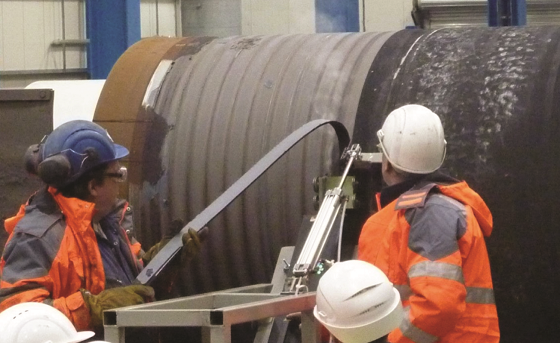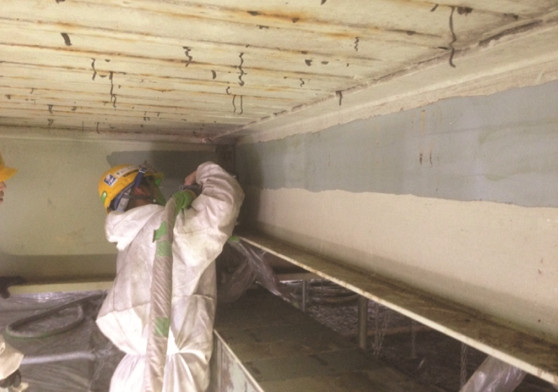The technology of removing coatings by heat induction was developed by Tom Arne Baann and Bjorn Erik Alveberg of Norway in 1996.1 A ship owner had challenged them to remove bacteria from the steel surfaces of a ballast tank. The bacteria were causing serious corrosion problems on the ship. Their idea was to kill the bacteria by heat. The intention was to kill the bacteria using heat induction without affecting the coating. The heat killed the bacteria, but the coating disbonded and came off in sheets. And so, coating removal by heat induction was born. This is the story of RPR Technologies AS of Norway that now holds several patents in the field. From that moment, the two inventors started the journey of developing, testing, and battling the obstacles up to where the company finds itself today. This novel technology is gaining its place and acceptance in the surface treatment industry as a valid and safe technique and an exciting complement to conventional abrasive and hydro-jetting methods.
Facility owners and coating contractors are looking for options where the old coating can be removed and disposed of without disturbing ongoing processes and work. As regulations are getting stricter and disposal costs are going up, it is critical to reduce the disposal volume. As there is no grit or water involved in coating removal by heat induction, only the hazardous material itself needs to be disposed of. Heat induction is sometimes chosen as a method because it is silent. Noise level is often a key factor when working near living quarters on ships and offshore installations.
How Heat Induction Works
An electromagnetic field is created by sending an alternating current through a hand-held induction coil. This electromagnetic field sets up eddy currents in the steel surface, which creates heat. As the steel surface underneath the coating is rapidly heated, the chemical bond between the coating and steel is broken.

Heat induction is a clean, fast, safe, cost-effective, silent, and environmentally friendly way to remove coatings from ferrous substrates. Heat induction can easily remove coatings up to a thickness of 25 mm (1 inch). This makes heat induction highly competitive for removing thick coatings and coatings that are hard to remove by other methods. It is common to see production rates three times higher than traditional methods. It is also advantageous in environments sensitive to water and dust. Heat induction is environmentally friendly as the coating comes off in easy-to-dispose-of sheets, and no contaminants are being spread. Other work can be conducted as usual while coatings are removed by heat induction. Heat induction does not wear, reduce the thickness of, or otherwise weaken the treated material. Contaminants, such as chlorides, are removed together with the coating.
Coating removal by heat induction is beneficial for projects such as pipeline refurbishment, removal of pipeline coating before pipes are scrapped, storage tank refurbishment, refurbishment of steel bridges, and elevated storage tanks. The method is approved for asbestos removal. Heat induction provides a convenient way of removing rubber linings, fire protective coatings, insulation, as well as thick coatings from a steel surface.
A technology institute conducted a study on the induction disbonder and concluded that the technique saves 75 percent on the electricity/fuel bill compared to conventional methods.2 When adding the savings in grit and water and the time spent in cleaning up, one is starting to envisage that coating removal through heat induction is very cost-effective. The thicker and harder to remove the coating, the greater the advantage over abrasive blasting and hydro-jetting.
Although the surface profile from the previous paint application is generally preserved, sometimes the surface needs further preparation to achieve the surface profile and cleanliness required by the paint manufacturer. A quick grit sweep typically accomplishes this. Even when such additional tasks are necessary, the heat induction process saves the project time and money.

Hazardous Coating Abatement
Heat induction is useful in removing hazardous materials such as lead paint, polychlorinated biphenyls (PCBs), and asbestos from steel surfaces. The dangerous material is not mixed with grit or water, keeping the volume of hazardous waste down. This makes for significant savings in the cost of collection, transportation, and disposal.
This is an excerpt from an article originally published in the January 2022 issue of Materials Performance. Reprinted with permission.
References
1. T.A. Baann, B.E. Alverberg, private communication, verbal, G. Solhaug (1996).
2. I. Lien, M. Berntsen, “Disbond,” Task 4.2, National Institute of Technology Department Environment and Safety, C3ST-CT-2001-50159, March 2004.